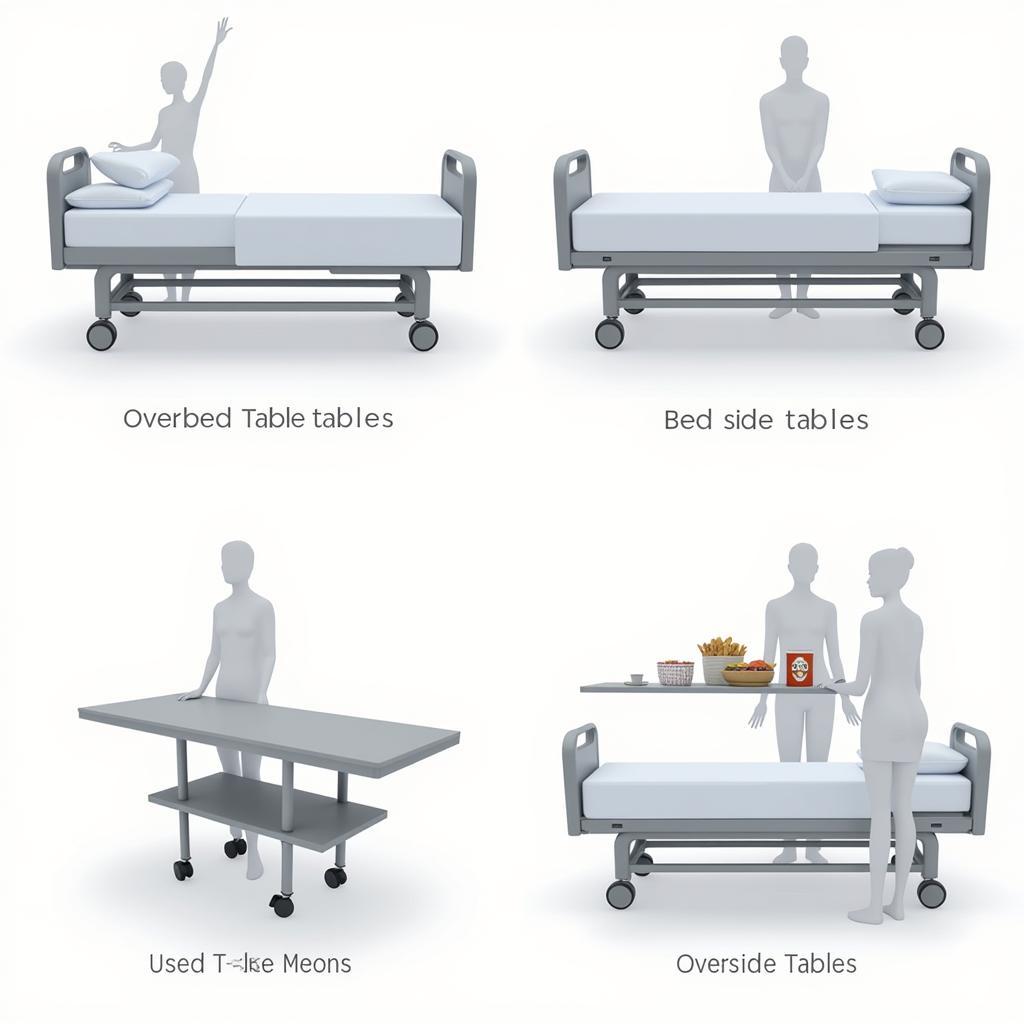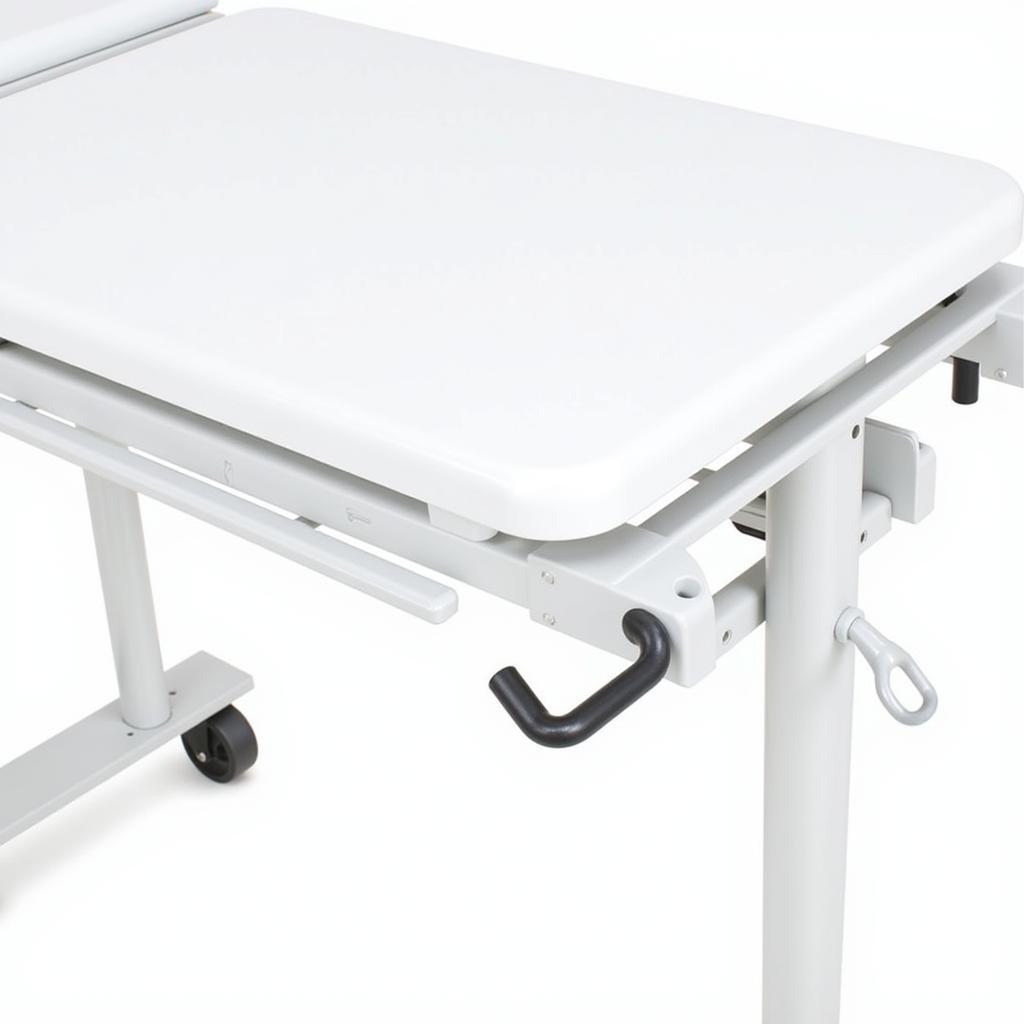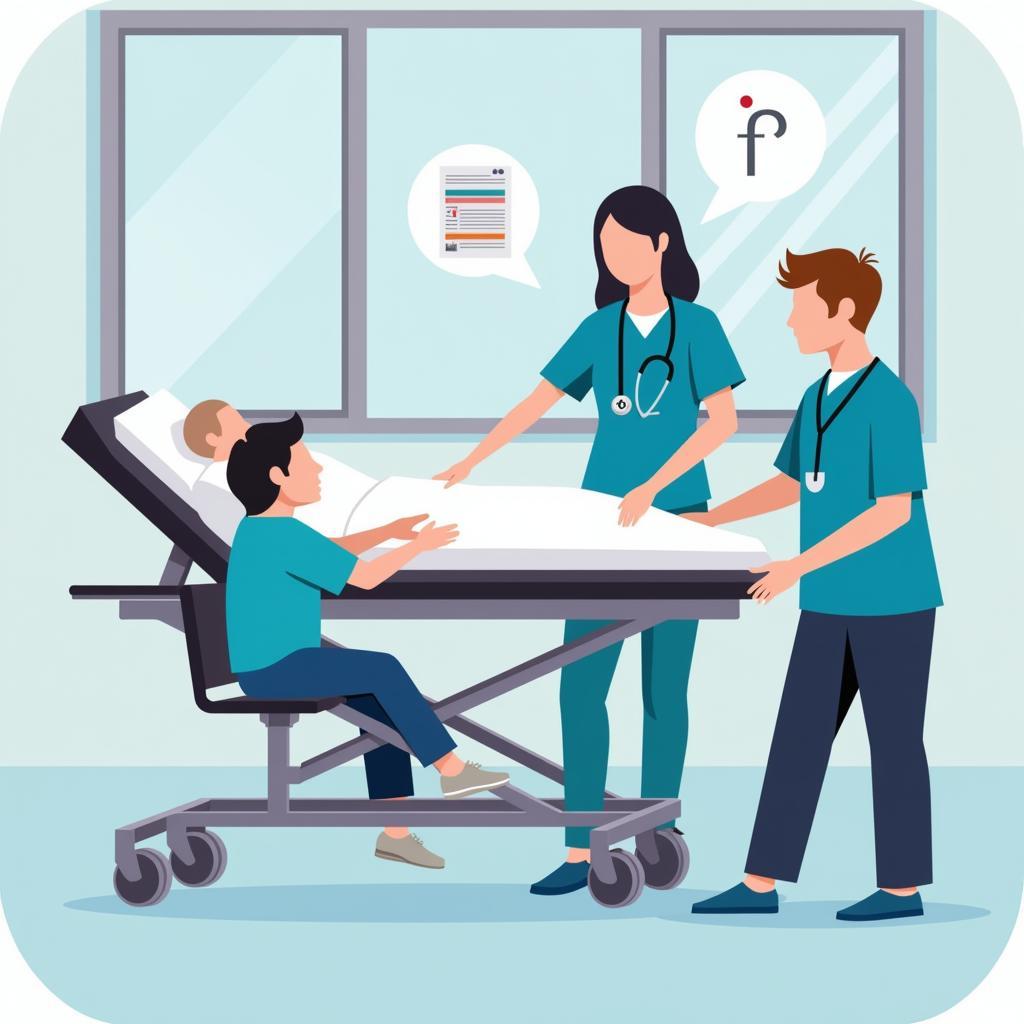Hospital Rolling Tables are essential pieces of equipment in any healthcare facility. They provide a convenient and mobile surface for patients to eat, work, or simply have items within easy reach. Choosing the right rolling table can significantly impact a patient’s comfort and recovery. This guide will explore everything you need to know about hospital rolling tables, from their various types and features to their benefits and how to choose the perfect one for your needs.
Types of Hospital Rolling Tables
Several types of hospital rolling tables cater to different patient needs and preferences. Understanding these differences is crucial for making an informed decision.
Overbed Tables
Overbed tables are designed to roll over a patient’s bed, allowing them to easily access items while lying down. These tables are typically height-adjustable and feature a tilting tabletop, making them ideal for reading, eating, or working on a laptop. Some rolling hospital bed table models even come with built-in storage drawers or compartments.
Bedside Tables
Bedside tables, while not always on wheels, are another essential piece of furniture in a patient’s room. They provide a stationary surface next to the bed for personal belongings, medications, and other necessities. While not as versatile as overbed tables, bedside tables offer a stable and convenient option for patients who don’t require a mobile surface.
Tray Tables
Tray tables are smaller and more portable than overbed tables. They are typically used for serving meals or providing a temporary workspace. Their compact size makes them easy to store and maneuver in tight spaces. Some hospitals also use a rolling hospital tray table to transport medical supplies and equipment between rooms.
 Types of Hospital Rolling Tables
Types of Hospital Rolling Tables
Key Features to Consider
When selecting a hospital rolling table, several key features can enhance patient comfort and convenience.
Height Adjustability
The ability to adjust the table height is essential for accommodating patients of different sizes and ensuring proper ergonomic positioning. Look for tables with a wide range of height adjustment options.
Tilting Tabletop
A tilting tabletop allows patients to adjust the angle of the surface for various activities, such as reading or writing. This feature can significantly improve comfort and reduce strain on the neck and back.
Mobility and Locking Casters
Smooth-rolling casters with locking mechanisms are crucial for easy maneuverability and stability. The table should be easy to move and lock securely in place to prevent accidental movement.
Durability and Cleanliness
Hospital environments require durable and easy-to-clean materials. Look for tables made from materials that can withstand frequent cleaning and disinfection.
 Key Features of Hospital Rolling Tables
Key Features of Hospital Rolling Tables
Benefits of Using Hospital Rolling Tables
Hospital rolling tables offer a range of benefits for both patients and healthcare providers. They promote patient independence, improve comfort, and enhance overall well-being.
- Increased Patient Independence: Rolling tables empower patients to access items and perform tasks without assistance, promoting a sense of independence and control.
- Enhanced Comfort and Convenience: Adjustable height and tilting tabletops provide personalized comfort and support for various activities.
- Improved Safety: Stable and secure tables minimize the risk of spills and accidents.
- Increased Efficiency for Healthcare Providers: Easily accessible surfaces streamline tasks for nurses and other healthcare professionals.
Choosing the Right Hospital Rolling Table
Choosing the right rolling table for hospital bed depends on the specific needs of the patient and the healthcare facility. Consider factors such as patient mobility, required functionality, and available space.
“When selecting a rolling table, prioritize patient comfort and safety,” advises Dr. Emily Carter, a leading expert in patient care and hospital equipment. “Consider the patient’s individual needs and choose a table that provides the appropriate level of support and functionality.”
 Choosing the Right Rolling Table
Choosing the Right Rolling Table
What is a Hospital Overbed Table?
A hospital overbed table is a specialized type of table designed to be positioned over a patient’s bed. This allows individuals who are bedridden or have limited mobility to comfortably access items without having to leave the bed. These tables offer adjustable height and tilting functionalities for enhanced user experience. A typical hospital overbed table is built on wheels for easy positioning and movement around the patient’s bed.
Why are Hospital Rolling Tables Important?
Hospital rolling tables play a vital role in patient care, contributing to their comfort, independence, and overall well-being. These tables provide a convenient surface for meals, reading, writing, and other activities, promoting a sense of normalcy and reducing the feeling of confinement. The mobility aspect of these tables also allows for easy adjustments and repositioning to suit the patient’s changing needs.
“Investing in high-quality hospital rolling tables demonstrates a commitment to patient-centered care,” adds Dr. Michael Davis, a renowned healthcare consultant. “These tables are a small but significant investment that can greatly improve the patient experience.”
Conclusion
Hospital rolling tables are a crucial component of patient care, providing comfort, convenience, and increased independence. By understanding the different types, features, and benefits, you can make an informed decision and choose the perfect hospital rolling table to enhance patient well-being. Consider the patient’s specific needs and choose a table that promotes comfort, safety, and a positive recovery experience.
FAQ
- What is the average height of a hospital rolling table? Most overbed tables are adjustable, typically ranging from 28 to 40 inches in height.
- What materials are hospital rolling tables made of? Common materials include laminate, wood, and metal, all chosen for durability and ease of cleaning.
- How do I clean a hospital rolling table? Follow hospital guidelines and use approved disinfectants to ensure proper hygiene.
- Are hospital rolling tables covered by insurance? Coverage varies depending on the individual’s insurance plan and the specific type of table.
- Where can I purchase a hospital rolling table? Medical supply stores, online retailers, and specialized hospital equipment providers are common sources.
- What is the weight capacity of a hospital rolling table? Weight capacity varies by model but generally ranges from 30 to 50 pounds.
- Can hospital rolling tables be used at home? Yes, they are often used for home healthcare and can be purchased for personal use.
Scenarios
- A patient recovering from surgery needs a table to eat meals and engage in light activities while in bed.
- A long-term care resident requires a table for personal belongings and activities to promote independence.
- A hospital needs durable and easy-to-clean rolling tables for efficient patient care.
Further Reading
You might also be interested in learning more about other hospital equipment and services. Visit our page on Fredericksburg Hospitality and Conference Center for more information.
For any assistance, please contact us at Phone Number: 02437655121, Email: [email protected] or visit us at: 298 Cau Dien Street, Minh Khai, Bac Tu Liem, Hanoi, Vietnam. We have a 24/7 customer service team.